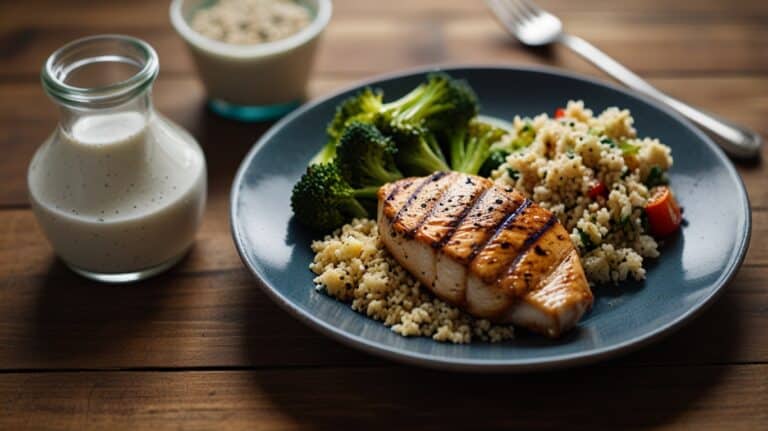Non-Scale Weight Loss Progress: How to Track Success Beyond the Numbers
When I stepped on the scale this morning, my heart sank. The numbers seemed to mock my hard work at the gym and the changes I saw in the mirror. It’s easy to get caught up in the scale’s tyranny, right? In this article, I will show you non-scale weight loss progress.
The scale only shows your total weight, not the details like bone density, water, fat, and muscle. Water weight changes, bone mass shifts, and muscle-fat ratios can affect the scale’s reading. This article will look at better ways to track your fitness journey, like progress photos, body measurements, strength gains, and how your clothes fit.
Key Takeaways
- The scale doesn’t tell the whole story of your fitness progress.
- Factors like water weight, bone density, and muscle-fat ratio can impact the number on the scale.
- Alternative tracking methods like progress photos, body measurements, and clothing fit can provide a more complete picture of your transformation.
- Focusing on non-scale victories, such as strength gains and improved body composition, can keep you motivated on your journey.
- A multifaceted approach to progress tracking is key for long-term success and a healthy relationship with the scale.
What the Scale Doesn’t Tell You
The number on the scale is just one part of tracking your health and fitness. It doesn’t show everything about your body. Water weight, bone density, muscle mass, and fat mass affect your weight too. The scale doesn’t give a full view of your body composition.
Factors Influencing Scale Weight
Weight changes happen often and can be due to many things. These include fluid retention, overeating salt, drinking alcohol, or the menstrual cycle. Gaining muscle from working out can also make the scale go up, even if you’re losing fat.
Limitations of Traditional Scales
Old-fashioned scales can’t tell the difference between muscle and fat. So, saying “muscle weighs more than fat” isn’t always true when tracking progress.
It’s better to look at body composition. This shows the percentage of fat versus muscle in your body. It gives a clearer picture of your health and fitness.
Knowing the scale’s limits helps you track your fitness journey better. It stops you from focusing too much on the numbers.

Capture Visual Progress with Photos
Progress photos are key in tracking your fitness journey. They show the changes in your body beyond just the scale. By comparing before and after shots, you can see your hard work, even if the scale doesn’t move fast.
Tips for Accurate Progress Photos
To get accurate progress photos, keep things consistent. Use the same lighting, outfit, and angles for each photo. Don’t pose or suck in your stomach. This way, you’ll see your body’s real progress over time.
Progress photos can boost your motivation and celebrate your fitness journey. Seeing your body change can make you feel good, like looking at cute animal photos. Let these photos motivate you to keep up with health and wellness.
Measure Strength Gains and non-scale weight loss progress
Tracking your strength gains is a key part of measuring your fitness journey. Start by setting baseline goals for exercises like squats, presses, and pulls. This lets you see how much you’ve improved over time.
Seeing your strength go up shows you’re building muscle and getting healthier. Even if you don’t see big changes on the scale, you’re still making progress. This is because muscle growth and fat loss can happen at the same time, without a big weight change.
Watching how you do in the gym is a great way to track your progress. Look at the weight you lift, the number of reps you do, or how fast you finish workouts. Getting stronger means you can lift more, do more reps, or finish workouts quicker.
These changes show you’re getting better at building muscle and improving your body’s shape, even if the scale doesn’t change.
Also, notice how your clothes fit over time. As you build muscle and lose fat, your clothes might start to fit differently. This shows your body is changing, even if the scale doesn’t reflect it.
Track Body Measurements
Keeping an eye on your body measurements is key to understanding your fitness progress. It goes beyond just looking at the scale. By tracking your waist, hips, thighs, chest, and other areas, you can see how your body changes over time.
Importance of Body Measurements
When you’re working on losing fat and gaining muscle, your body shape changes. The scale might not always show these changes. By measuring your body often, you can see where you’re losing inches and building muscle. This keeps you motivated, even if the scale doesn’t move.
Body measurements are crucial for tracking your fitness journey. They show progress the scale might miss, like less body fat or more muscle. Regular measurements help you check your body composition. This ensures you’re reaching your goals, whether it’s losing fat, gaining muscle, or improving health and fitness.
Assess Body Composition Changes
The scale is useful, but it doesn’t show everything about your fitness progress. Looking at your body composition gives deeper insights into changes in your body. Skinfold measurements are a cost-effective way to track changes in your body fat over time.
Skinfold Measurements
Skinfold measurements use calipers to measure skin thickness at different body points. This helps estimate your body fat percentage. Regular tracking of these measurements shows changes in body fat, even if the scale doesn’t change.
DEXA Scans
For a detailed look at your body composition, consider a DEXA scan. These scans give info on fat, muscle, and bone density. DEXA scans are pricier than skinfold measurements but offer a deeper look at your body’s changes during your fitness journey.
Try on Old Clothes
Trying on old clothes is a great way to see your fitness progress. As you lose fat and build muscle, your clothes fit better, even if the scale doesn’t change. Wearing jeans that were once too tight or feeling good in your favorite shirt shows how your body has changed.
These changes in how your clothes fit are key to seeing your progress. They help you focus on your health and well-being, not just the scale. Your strength, energy, and how your clothes fit are just as important as your weight.
Don’t worry if the scale moves slowly. Try on your old clothes and celebrate your small wins. These victories are motivating and keep you focused on your fitness journey.
Speaking of non-scale victories, have you considered how plant toxins might be sabotaging your wins?
We all love celebrating tighter jeans or that newfound spring in our step—but what if hidden culprits in your diet are holding you back? Plants like spinach, beans, and nuts contain natural compounds like lectins, oxalates, and phytates.
While these sound fancy, they’re basically a plant’s defense system, and for some of us, they can trigger inflammation, mess with digestion, or zap your energy. For years, I prided myself on eating “clean”—think kale salads, lentil soups, and almond butter.
Yet, I still dealt with stiff joints, bloating after meals, and afternoon crashes that made me resent my 2 p.m. alarm. Turns out, those “healthy” plants were not my friends.
Here’s the twist: going carnivore (think meat, fish, eggs, and animal fats) cuts out those plant toxins completely. No more oxalates causing inflammation in your joints, lectins irritating your gut lining, or phytates blocking your body from absorbing key nutrients like magnesium and iron.
When I switched to carnivore, the bloating vanished within days, my energy stayed steady all afternoon, and even my skin cleared up—a win the scale never could’ve shown me. Plus, without the blood sugar rollercoaster from carbs, my cravings flatlined, making it easier to tune into my body’s true hunger signals.
If you’re nailing your workouts, sleeping better, or finally fitting into old clothes but still feel like something’s “off,” plant toxins might be the sneaky reason.
Conclusion
We’ve looked at many ways to track your fitness progress, not just by the scale. The scale is useful, but it’s not the only way to measure success. You can also use progress photos, body measurements, strength gains, and body composition analysis.
It’s great to celebrate your progress, like fitting into smaller clothes or feeling more energetic. These achievements can make you feel better about yourself and keep you motivated. They show that you’re moving forward, even if the scale doesn’t change.
Your main goal should be to get healthier and feel better, not just to reach a certain weight. Focus on making steady progress, and your weight will likely follow.
By tracking your progress in different ways, you’ll get a full picture of how you’re changing. This helps you keep moving forward on your fitness path.





